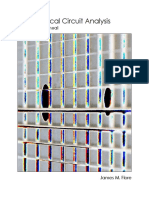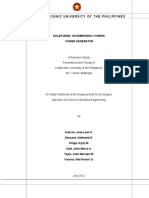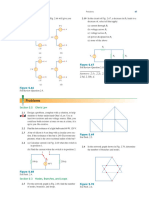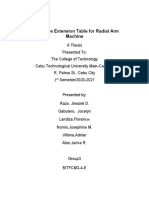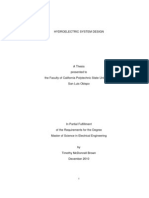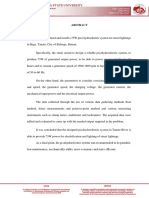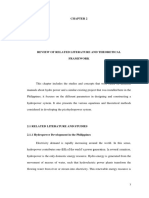Bataan Peninsula State University
College of Engineering and Architecture
Department of Electrical Engineering
City of Balanga
A Feasibility/Project Study on
DESIGN AND INSTALLATION OF 75W PICO HYDROELECTRIC
SYSTEM FOR STREET LIGHTING IN BRGY. TANATO, CITY OF
BALANGA, BATAAN
In partial fulfillment of the requirements for the degree of Bachelor of Science in
Electrical Engineering for the subject EEPS-521 (EE Project Study)
By:
Dungo, Alpha Karina L.
Carriedo, Karlo O.
Fernandez, James Elwin L.
Ferrera, Hanz Christian T.
Lazarte, Wilson D.
Martin, Melvin Ralph M.
May 16, 2018
i
� APPROVAL SHEET
This is to certify that we have supervised the preparation of and read the project study
prepared by Dungo, Alpha Karina L. Carriedo, Karlo O., Fernandez, James Elwin
L., Ferrera, Hanz Christian T., Lazarte, Wilson D. and Martin, Melvin Ralph
Entitled “DESIGN AND INSTALLATION OF 75W PICO HYDROELECTRIC
SYSTEM FOR STREET LIGHTING IN BRGY. TANATO, CITY OF
BALANGA, BATAAN” and that the said project has been submitted for final
examination by the Oral Examination Committee.
_________________________
Engr. Roland S. Manalang
Instructor
As members of the Oral Examination Committee, we certify that we have
examined this feasibility/project study or research report presented before the
committee on May 9, 2017, and hereby recommended that it be accepted as fulfillment
of the Feasibility/Project Study or Research Report requirement for the degree in
Bachelor of Science in Electrical Engineering.
ii
�______________________ _____________________
Engr. Greg C. Mallari Engr. Frelie C. Poblete
Panel Member Panel Member
____________________
Engr. Allan Gaile Porcioncula
Panel Member
This project study report is hereby approved and accepted by the Bataan
Peninsula State University as fulfillment of the feasibility/project study or research
report requirement for the degree in Bachelor of Science in Electrical Engineering.
_________________________
Engr. Nelson S. Andres
Dean, College of Engineering and Architecture
iii
� LETTER OF TRANSMITTAL
May 9, 2017
Engr. Nelson S. Andres
Project Study Adviser
Department of Electrical Engineering
College of Engineering and Architecture
Bataan Peninsula State University
Balanga City, 2100 Philippines
Dear Engr. Nelson S. Andres,
In compliance with the fulfillment of the requirement on the subject “EEPS-521
(EE Project Study)”, the proponents would like to present the Project Study entitled
“DESIGN AND INSTALLATION OF 75W PICO HYDROELECTRIC SYSTEM
FOR STREET LIGHTING IN BRGY. TANATO, CITY OF BALANGA,
BATAAN”, in accordance with your instructions.
The main purpose of this study is to prove the potential of producing electrical
energy using a renewable source of energy which is hydro power. This project may
serve as a reference material for harnessing and utilization of hydro energy to produce
power and use it for street lighting. This project also aims to resolve energy inadequacy
in the remote areas which are not accessible by distribution utility.
We, the researchers, hope that this project will meet your approval. Anything
that we can do for the further improvement of the project will be willingly appreciated.
iv
�Sincerely,
Dungo, Alpha Karina L.
Carriedo, Karlo O.
Fernandez, James Elwin L.
Ferrera, Hanz Christian T.
Lazarte, Wilson D.
Martin, Melvin Ralph M.
v
� TABLE OF CONTENTS
Title Page . . . . . . . . . i
Approval Sheet . . . . . . . . ii
Letter of Transmittal . . . . . . . . iv
Table of Contents . . . . . . . . vi
List of Tables . . . . . . . . . x
List of Figures . . . . . . . . xi
Abstract . . . . . . . . . xiii
Acknowledgement . . . . . . . . xiv
Chapter I: The Problem And its Background
1.1 Introduction . . . . . . . . 1
1.2 Statement of the Problem . . . . . . 4
1.3 Significant of the Study . . . . . . 5
1.5 Scope and Limitation . . . . . . 6
Chapter II: Review of Related Literature and Theoretical Framework
2.1 Related Literature and Studies 7
2.1.1 Hydropower Development in the Philippines 7
2.1.2 Case Study on Micro-Hydro Power Plants on the Philippines 8
2.1.3 Pico-Hydro Electric Plant Installation in Aguinaldo, Ifugao 8
2.1.4 Filipino Micro Hydro Project - Powering a corn mill and lighting 60 homes
in the Philippines 9
2.1.5 Design and Installation of Pico-Hydropower in Barangay San Andres,
Tanay, Rizal 9
2.1.6 Pico Hydroplant in Hanabian, Southern Leyte 10
2.1.7 Kirinyaga District, Kenya Pico Hydropower Plant 10
vi
�2.1.8 Pico Hydroelectric Plant in Kerala and Karnataka, India 11
2.1.9 Pico Hydro systems in Thapene village 12
2.2 Theoretical Framework 12
2.2.1 Pico Hydropower Technology 12
2.2.2 Primary Parts of Pico Hydroelectric System 13
2.2.2.1 Water Supply 13
2.2.2.2 Intake 13
2.2.2.3 Penstock 14
2.2.2.4 Turbine 14
2.2.2.5 Power House 16
2.2.2.6 Drive and Bearing System 16
2.2.3 Pico Hydro System Theory of Operation 17
2.2.4 Flow Rate 17
2.2.5 Mechanical Power 18
2.2.7 Battery 19
2.2.7.1 Stages of Battery Charging 19
2.2.7.2 Depth of discharge (DOD) 20
2.2.7.3 State of charge (SOC) 20
2.2.7.4 Battery capacity (Ah) 21
2.2.8 Generator 22
2.2.8.1 Working Principle of an Alternator 22
2.2.8.2 Construction of Alternator 23
2.2.8.3 Frequency of an Alternator 24
2.2.9 LED Street Lighting System 24
2.2.9.1 LED Lamps 25
2.2.9.3 Street Light Illumination 25
2.3 Hypotheses of The Study 26
2.4 Conceptual Framework 27
2.5 Definition of Terms 28
vii
�Chapter III: METHODOLOGY
3.1 Planning 31
3.1.1 Gantt Chart 31
3.1.2 System Planning
3.2 Site Selection and Evaluation 32
3.3 Selection of Component Criteria 34
3.3.1 Selection of Turbine 34
3.3.2 Selection of Penstock 34
3.3.3 Selection of Generator 34
3.3.4 Selection of Drive System 35
3.3.5 Selection of Battery 35
3.3.5.1 Load Modeling and Battery Sizing 35
3.3.6 Selection of Lamps 37
3.4 Design and Fabrication of Components 38
3.4.1 Design of Pico Hydroelectric System 38
3.4.2 Canvassing and Procurement of Materials and Components 39
3.4.3 Fabrication of Turbine 41
3.4.4 Fabrication of Penstock and Inlet 43
3.4.5 Fabrication of Powerhouse and Gate 47
3.4.6 Construction of Drive System 47
3.5 Component and Circuit Assembly 47
3.5.1 Circuit Assembly 47
3.5.2 Component Assembly 48
3.6 Installation 49
3.6.1. System Installation 49
3.6.2 Street Light Installation 49
3.7 Testing and Data Gathering 50
viii
� 3.7.1 Flow Rate Measurement 51
3.7.2 Turbine and Generator Speed Measurement 52
3.7.3 Alternator and Load Current Measurement 53
3.7.4 Alternator and Load Voltage Measurement 53
3.7.5 Illumination Measurement 54
Chapter IV: DATA AND RESULTS
4.1 Measurement of Water Flow Rate 55
4.2 Fabrication Specification 56
4.3 Measurement of Turbine and Generator Load Characteristics 59
Chapter V: Summary of Findings, Conclusion and Recommendation
5.1 Summary of Findings 68
5.2 Conclusion 69
5.3 Recommendations 71
Bibliography 72
Curriculum Vitae 75
ix
� List of tables
Table 2.1 Turbine Classifications 15
Table 2.2 Minimum amount of Illumination and CRI for corresponding Areas 26
Table 3.1 Gantt Chart 31
Table 3.2 River Analysis 33
Table 3.3 Tabulation of Loads 36
Table 4.1 Monthly River Profile Analysis 56
Table 4.2 Penstock Specification 57
Table 4.3 Turbine Specification 57
Table 4.4 Drive System Specifications 58
Table 4.5 Mechanical Input Power and Parameters Analysis 58
Table 4.6 Turbine and Generator Speed and Frequency Analysis 59
Table 4.7 Electrical Power Output and Parameters Analysis 60
Table 4.8 Speed Regulation and Parameters 61
Table 4.9 Overall Efficiency and Parameters 62
Table 4.10 Illumination Parameters 63
Table 4.11 Component and Material Costing 64
x
� List of figures
Fig. 1.1 Electricity-Generating Plants in the Philippines 2
Fig. 1.2 Power Generation per Source in the Philippines 2
Fig. 1.4 Tanato Bridge 3
Fig. 2.1 Assembly of Turbine-generator and Construction of Forebay 9
Fig 2.2 Operational Project and Rice Mill 9
Fig. 2.3 Operational Powerhouse and Penstock Setting up 10
Fig. 2.4 Pico Hydro in Kerala and Karnataka 12
Fig. 2.5 Head – Flow Rate Nomogram 15
Fig. 2.6 Turbine Head and Efficiency Relationship 16
Fig. 2.7 Pico Hydro Energy Transformation 17
Fig 2.8 Three Stages of Battery Charging 19
Fig. 2.9 Cycles vs. Depth of Discharge 20
Fig. 2.10 C/rates at different hours 21
Fig. 2.11 Rotating Magnetic Field Concept 22
Fig. 2.12 When rotor is made to rotate electricity gets induced in armature coils 23
Fig. 2.13 Basic Construction of an Alternator 23
Fig. 2.14 Life-cycle energy consumption of incandescent, CFL and LED lamps 25
Fig. 2.15 Conceptual Framework 27
Fig. 3.1 Overall Project Flow 31
Fig. 3.2 Site Visitation in Tanato and Damulog River 33
Fig. 3.3 Site Location – Tanato River Park 33
Fig. 3.4 Flowchart of Design and Fabrication 38
Fig. 3.5 Design of Pico Hydro 38
Fig. 3.6 Basic Operational Diagram 39
Fig. 3.7 Suzuki Daihatsu Alternator 40
Fig. 3.8 Sealed-ball Bearing 40
Fig. 3.9 60Ah Lead Acid Battery 40
Fig. 3.10 12Vdc to 220Vac Inverter 41
xi
�Fig. 3.11 12V Automatic Voltage Regulator 41
Fig. 3.12 LED Lamps 41
Figure 3.13 Isometric View of the Turbine 42
Figure 3.14 Water Wheel Dimensions 42
Fig. 3.15 Fabrication of Undershot Water Wheel 43
Fig. 3.16 Undershot Waterwheel 43
Fig. 3.17 Isometric View of the Penstock and Inlet 44
Fig. 3.18 Penstock and Inlet Dimensions 45
Fig. 3.19 Fabrication of Penstock and Inlet 46
Fig. 3.20 Penstock with Inlet 46
Fig. 3.21 Drive System Dimensions 47
Fig. 3.22 Alternator to Inverter Circuit 48
Fig. 3.23 Installation of Pico Hydroelectric System 49
Fig. 3.24 Dimensions of Proposed Installation of Street Lightings 50
Fig. 3.25 Street Lightings 50
Fig. 3.26 Testing and Data Gathering Flowchart 51
Fig. 3.27 Flow Rate Measurement 52
Fig. 3.28 Speed Measurement 52
Fig. 3.29 Current Measurement 53
Fig. 3.30 Voltage Measurement 54
Fig. 4.1 Voltage-Time-Speed Relation 61
xii
� ABSTRACT
The study aimed and install a 75W pico hydroelectric system for street lightings
in Brgy. Tanato, City of Balanga, Bataan.
Specifically, the study aimed to design a reliable picohydroelectric system, to
produce 75W of generated output power, to be able to power up street lights for 12
hours and to sustain a generator speed of 1500-1800 rpm to have an output frequency
of 50 to 60 Hz.
On the other hand, the parameters to consider consisted of the turbine torque
and speed, the generator speed, the charging voltage, the generator current, the
mechanical input power and the electrical output power.
The data collected through the use of various data gathering methods float
method, direct measurements and point-to-point method and various measuring
instruments such as clamp meter, multitester and tachometer. The acquired data were
tallied and evaluated to come up with the needed output required in the problem.
It was concluded that the designed picohydroelectric system in Tanato River is
able to provide 75W power for electrification and lighting of street lightings.
As a final point, the picohydroelectric system was recommended to be portable,
low maintenance, mechanically stable, more economic and more efficient.
xiii
� ACKNOWLEDGEMENT
This project consumed vast amount of work, research and dedication. Still,
implementation would not have been possible and accomplished without the help of
people whose support, guidance, and assistance serve as the fueling motivation for the
researchers. Therefore, the researchers would like to extend genuine gratitude to all of
them.
First and foremost, the researchers would like to acknowledge Almighty God,
for his unconditional love, kindness and most especially for giving the skills, good
health, and knowledge that led the researchers to the development and completion of
their study.
The researchers would like to express their heartfelt gratitude to their ever
beloved parents their Mom and Dad for the unending love and support on whatever
decision they made, and for their financial assistance on this project matter.
The researchers also wish to thank their friends and batch mates, BSEE5, for
giving them some ideas on how they will do their project.
And of course, the researchers would like to place on record their deepest
gratitude to the officials of Bataan Peninsula State University and mostly our supportive
adviser/Dean Engr. Nelson S. Andres, for teaching and for giving them the opportunity
to construct and design a project that can generate electricity and can help the
environment, for enlightening their minds every time they encounter problems in
calculating, designing, and testing this project and for his guidance towards to the
progression and completion of this project study.
And finally, to all people who in their own way made this project possible, thank
you and may God bless you!
xiv





